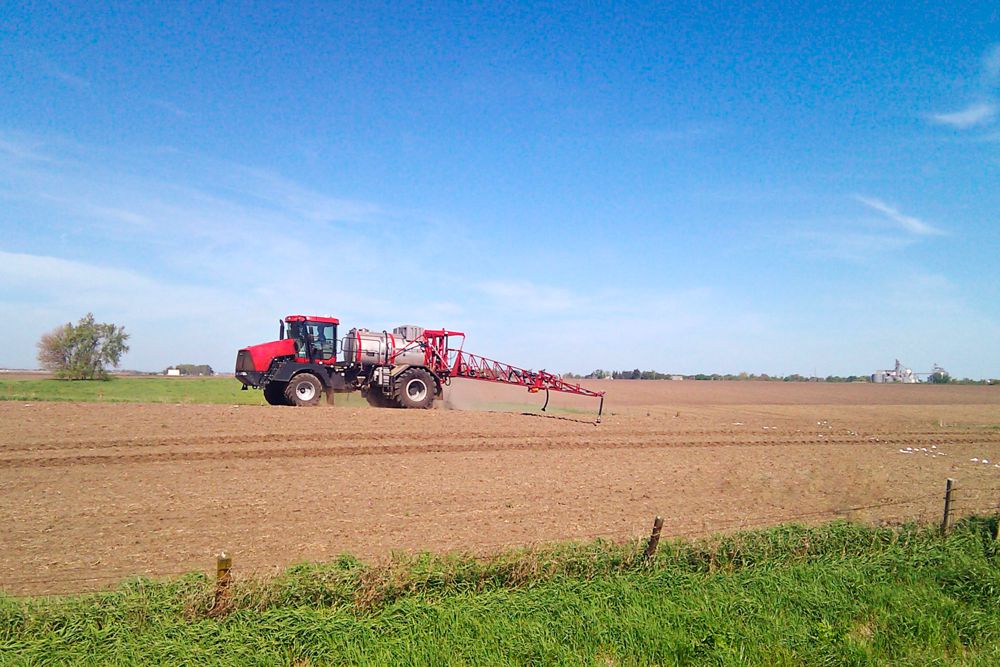When it comes to spring spraying, every second counts. An equipment failure when perfect conditions finally align could be detrimental to a pest control plan.
Luckily, winter offers a period of downtime between seasons, when farm equipment can be brought into top shape.
“Wintertime is when we finish what we started,” says Fred Whitford, director of Purdue Pesticide Programs. “You’ve used these sprayers, you’ve made money out of them. They’ve protected your crop against weeds, insects, and diseases. Now is the time to give them a little loving care, so that next year they’re ready to roll.”
While each sprayer and system is different, some general maintenance is the first step to ensure a smooth start to the growing season.
Check Hoses and Nozzles
Spray Hoses
Spray hoses that lie on other pieces of equipment, such as metal frames or nuts, are prone to wear and tear. Check each hose laying on another piece of equipment for rub marks. Replace or reroute hoses with compromised construction to prevent failures when they’re put under pressure.
Some simple solutions can extend the life of hoses in prone areas. “You can attach a piece of rubber or a sacrificial hose over the pressure hose to take the rubbing,” Whitford says.
Also, evaluate hoses for dry rot, and replace them if they appear to have lost their moisture.
Use double hose clamps with screws turned in opposite directions in any spot a hose is clamped to the equipment.
“There’s a science behind that,” Whitford says. “Where the screws are is not as tight as the round piece of the clamp. When you alternate them, there’s a tight piece against the screw and vice versa.”
T-Bolt clamps are another option to ensure a tighter fit.
Hydraulic Hoses
Check hydraulic hoses for leaks, especially in areas where fluids could eat away at hose coverings and the wires underneath. Replace compromised hoses as soon as possible.
“These hoses are under extreme pressure, and people can be severely injured when things break,” Whitford says.
Nozzles
Well-functioning nozzles can significantly impact product efficiency. Blockages, spray disruptions, and internal wear can lead to uneven product distribution. Routinely conduct spray tests to evaluate nozzle performance.
“You can very much optimize your application with nozzles,” says Austin Weiss, a staff product application specialist at Syngenta. “If you’re not getting good control, you can look at your nozzles. They don’t necessarily solve the problem, but they can be part of the solution.”
For more information about the importance of sprayer nozzles, check out the November 2024 edition of Weeds Playbook here.
Tanks and Fittings
While the poly tanks used by many farmers are relatively inexpensive, they also break down when exposed to pro-longed sunlight. A simple test with a water-soluble marker can help evaluate whether tanks need replacing.
“A water-soluble pen, like a whiteboard marker, will penetrate any cracks from sunlight,” Whitford says. “When you wipe the ink off the surface, you can actually see what looks like dry rot or alligator skin, and that is telling you that the tank is breaking down.”
Farm equipment usually comes with a diagram with the location of each fitting that needs greasing. The slow period of winter is a great opportunity to pull that out and ensure proper maintenance.
When completing maintenance, use the manufacturer-recommended oil formula and grease characteristics, especially when the equipment is still under warranty.
“A lot of people will use a general-use grease, which
is probably good 80% of the time,” Whitford says. “But some greases need a certain viscosity to work. If you want to maintain your warranty, it’s important that you follow through with what the equipment manufacturer suggests.”
Cappi Thompson, Getty Images
Boom and Tires
Don’t overlook the major pieces of a sprayer system.
Evaluate the boom, section by section, for cracks and stress points. If needed, use the winter months to make welded repairs.
“If you had a crack on a boom you didn’t notice in the winter, and you end up with a boom failure in the field, that is a huge repair and a lot of downtime,” says Aaron Herrmann, a research agronomist at Precision Planting.
Also, keep tires in good condition. Inspect for checkered marks or worn rubber, especially after entering a field with cornstalks or other debris.
Flush and Winterize the System
An effective system flush removes any residual herbicides.
Whitford recommends using a commercial tank cleaner, which pulls chemicals out of the hoses and breaks them down within the tank.
Winterizing the equipment following a flush ensures that any remaining water cannot freeze and damage the system.
“Don’t use a truck or car antifreeze,” Whitford says. “Use something like an RV antifreeze, and flush the system until what comes out of the nozzles is the same color as what you’re putting in.”
Storage Considerations
Once maintenance has been done, optimizing storage ensures that the equipment is in ready-to-go condition come spring. Often, equipment is kept in an unheated barn, which can lead to frozen batteries.
“A partially charged battery is going to freeze at 32°F, while a fully charged battery can be in temperatures as
low as minus 76°F,” Whitford says. He recommends that farmers keep batteries inside and on a trickle charger to preserve them.
Rodents can also cause extensive and expensive damage to equipment by chewing on wires. Consistent rodent control in storage areas can limit the need for expensive repairs that require specialist technicians.
